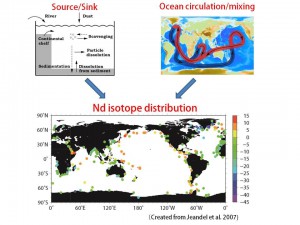Akira Oka
Modelling of neodymium isotope distribution in the ocean as a tool for quantifying the ocean mixing processes
Research summary
Trace elements in the ocean have been used for quantifying the ocean circulation and mixing processes. In 1970s, GEOSECS program clarified the distribution of radio carbon in the ocean, by which the time scale of the ocean deep circulation was quantified. After GEOSECS, clean measurement was established and it is possible to measure nmol/kg-level trace elements. GEOTRACES program for clarifying global distribution of such nmol/kg-level trace elements is now starting. Neodymium is one of such trace elements and its isotope ratio is listed as a “key parameter” of GEOTRACES program because neodymium isotope is believed to be a quasi-conservative tracer in the ocean and therefore useful for quantifying the mixing processes of different ocean water. On the other hand, recent studies suggest that distribution of neodymium is affected by a scavenging process onto particles; distribution of neodymium isotope is also expected to be affected by internal recycling processes associated with scavenging, particle dissolution, and so on. Therefore, in order to utilize neodymium isotope for quantifying the mixing processes in the ocean, we need to explicitly evaluate internal recycling processes.
In this study, we try to simulate the global distribution of neodymium isotope in the ocean by using an ocean general circulation model. In this simulation, in addition to external source/sink of neodymium, the internal recycling processes including scavenging are explicitly taken into account. From these simulations, we try to quantify how the distribution of neodymium isotope is controlled by ocean mixing.
Principal investigator :
Akira Oka
University of Tokyo, Atmosphere and Ocean Research Institute, Associate Professor, Ocean modelling
Collaborator :
Hajime Obata
University of Tokyo, Atmosphere and Ocean Research Institute, Marine Geochemistry
Collaborator:
Hirofumi Tazoe
Hirosaki University, Institute of Radiation Emergency Medicine, Assistant Professor, Chemical Oceanography





